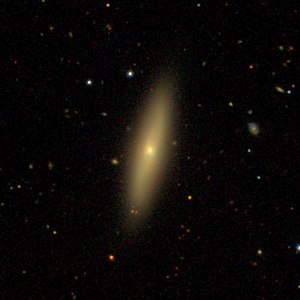NGC 5475
| Galaxy NGC 5475 |
|
|---|---|

|
|
| SDSS recording | |
| AladinLite | |
| Constellation | Big Bear |
|
Position equinox : J2000.0 , epoch : J2000.0 |
|
| Right ascension | 14 h 02 m 12.4 s |
| declination | + 55 ° 44 ′ 31 ″ |
| Appearance | |
| Morphological type | Sa? sp |
| Brightness (visual) | 12.6 mag |
| Brightness (B-band) | 13.5 likes |
| Angular expansion | 1.9 ′ × 0.5 ′ |
| Position angle | 166 ° |
| Surface brightness | 12.4 mag / arcmin² |
| Physical data | |
| Affiliation | LGG 373 |
| Redshift | 0.005574 ± 0.000017 |
| Radial velocity | (1671 ± 5) km / s |
|
Stroke distance v rad / H 0 |
(80 ± 6) · 10 6 ly (24.6 ± 1.7) Mpc |
| history | |
| discovery | Wilhelm Herschel |
| Discovery date | April 14, 1789 |
| Catalog names | |
| NGC 5475 • UGC 9016 • PGC 50231 • CGCG 272-024 • MCG + 09-23-33 • GC 3784 • H II 800 • h 1750 • LDCE 1029 NED004 | |
NGC 5475 is a 12.6 likes bright spiral galaxy of Hubble type Sa in the constellation Ursa Major at the northern sky , the estimated 80 million light-years from the Milky Way 's center.
The object was discovered on April 14, 1789 by Wilhelm Herschel with an 18.7-inch reflector telescope, who described it as "pB, S".
